Financial Decision Making at Tesco PLC: A Comprehensive Analysis
VerifiedAdded on 2021/01/02
|14
|3915
|500
Report
AI Summary
This report delves into the financial decision-making processes of Tesco PLC, a major British multinational retailer. It examines the crucial roles of accounting and finance functions within the organization, including financial accounting, management accounting, and auditing. The report highlights the importance of these functions in managing cash flow, directing business strategies, and providing financial information to stakeholders. It explores specific functions like investment and dividend decisions, evaluating their advantages and disadvantages. The analysis includes discussions on setting budgets, analyzing costs, and managing debt, demonstrating how effective financial management contributes to Tesco's overall success. The report provides insights into the application of various financial tools and techniques, offering a comprehensive overview of Tesco's financial operations.

FINANCIAL
DECISION MAKING
DECISION MAKING
Paraphrase This Document
Need a fresh take? Get an instant paraphrase of this document with our AI Paraphraser
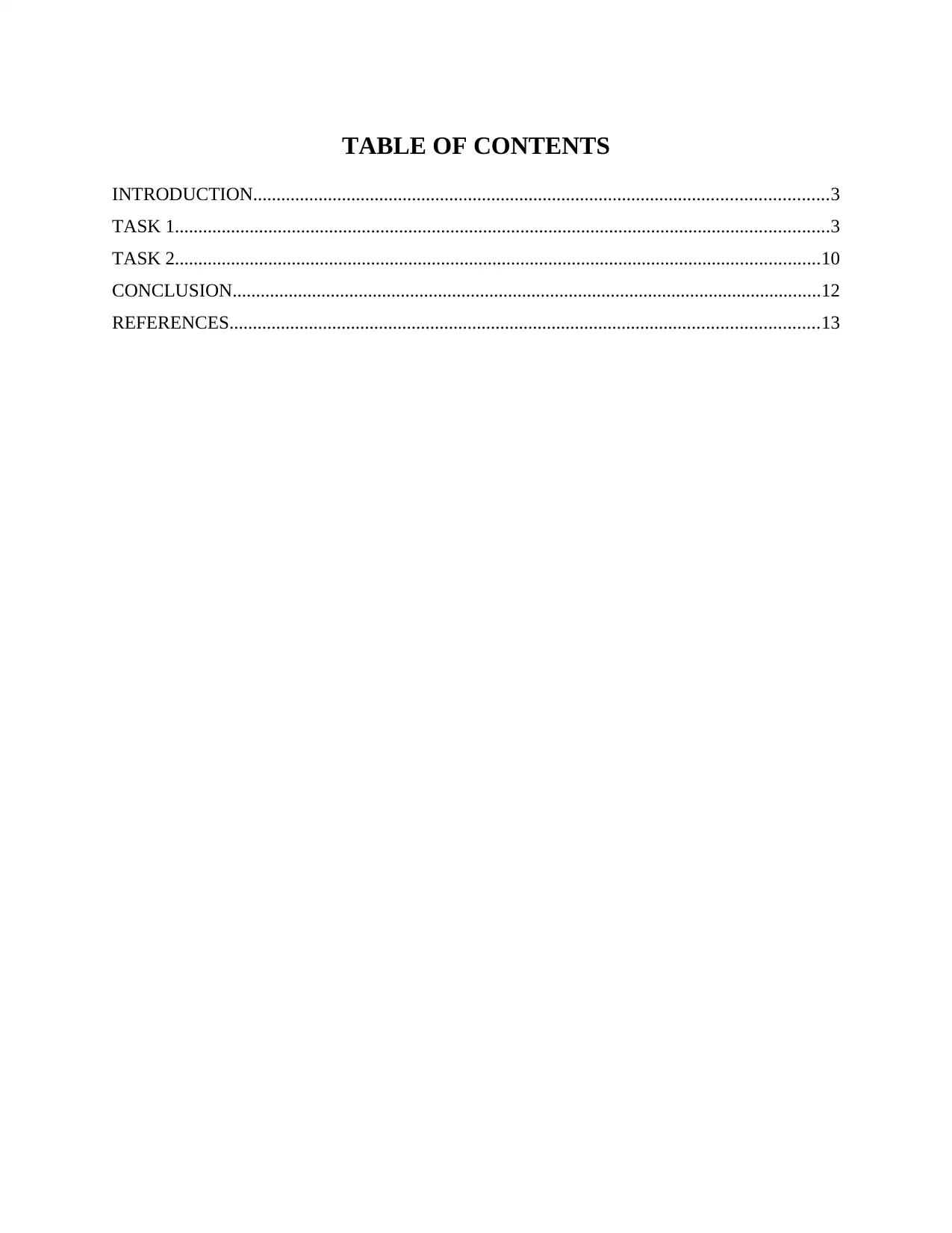
TABLE OF CONTENTS
INTRODUCTION...........................................................................................................................3
TASK 1............................................................................................................................................3
TASK 2..........................................................................................................................................10
CONCLUSION..............................................................................................................................12
REFERENCES..............................................................................................................................13
INTRODUCTION...........................................................................................................................3
TASK 1............................................................................................................................................3
TASK 2..........................................................................................................................................10
CONCLUSION..............................................................................................................................12
REFERENCES..............................................................................................................................13

INTRODUCTION
Financial decision making is the process which is responsible for all the decision related
with the finance , liabilities and stockholder's equity of company as well issuance of the bonds .
It is concerned with another crucial decisions made by the financial manger relating to the
financing mix of the organisation and also concern with borrowing and allocation of funds which
Is required for the investment decision.
The present study is based on the Tesco plc which is trading company and a British
multinational groceries and general merchandise retailer company. it is the third largest retailer
in the world in context with the gross revenue .
Furthermore,. The study will explain about the importance of the accounting and finance
function In the given organisation ad also the different accounting and finance functions which
includes different function, investment function, working capital function, auditing unction, tax
function etc. which are essential forte organisation for different activities performed by them at
their levels. Te study Wil also introduce about different ratios of the Alpha ltd which helps in
ascertaining the performance of the company.
TASK 1
Tesco plc which is trading company and a British multinational groceries and general
merchandise retailer company. it is the third largest retailer in the world in context with the gross
revenue . It headquarter in Welwyn garden city, England, UK. It is ninth largest retailer in the
world if measured by the revenues.
Accounting and finance plays very crucial roe in any organisation and in the
management of the company(Quattrone, 2016). By appropriately and effectively accounting it
helps the company to manage their flow of money and also direct the course of the business,
major use of the financial accounting is to recording of the transactions is to record each inflow
and outflow the business which helps the business in ascertaining the true and fair financial
position. financial accounting is the function of the accounting which helps Tesco in providing
the methodological approach in describing the activities of the business.
Accounting is the important factor for every business and is required in the company to
record all the business transactions(Petria, Capraru and Ihnatov, 2015) . It also helps in
Financial decision making is the process which is responsible for all the decision related
with the finance , liabilities and stockholder's equity of company as well issuance of the bonds .
It is concerned with another crucial decisions made by the financial manger relating to the
financing mix of the organisation and also concern with borrowing and allocation of funds which
Is required for the investment decision.
The present study is based on the Tesco plc which is trading company and a British
multinational groceries and general merchandise retailer company. it is the third largest retailer
in the world in context with the gross revenue .
Furthermore,. The study will explain about the importance of the accounting and finance
function In the given organisation ad also the different accounting and finance functions which
includes different function, investment function, working capital function, auditing unction, tax
function etc. which are essential forte organisation for different activities performed by them at
their levels. Te study Wil also introduce about different ratios of the Alpha ltd which helps in
ascertaining the performance of the company.
TASK 1
Tesco plc which is trading company and a British multinational groceries and general
merchandise retailer company. it is the third largest retailer in the world in context with the gross
revenue . It headquarter in Welwyn garden city, England, UK. It is ninth largest retailer in the
world if measured by the revenues.
Accounting and finance plays very crucial roe in any organisation and in the
management of the company(Quattrone, 2016). By appropriately and effectively accounting it
helps the company to manage their flow of money and also direct the course of the business,
major use of the financial accounting is to recording of the transactions is to record each inflow
and outflow the business which helps the business in ascertaining the true and fair financial
position. financial accounting is the function of the accounting which helps Tesco in providing
the methodological approach in describing the activities of the business.
Accounting is the important factor for every business and is required in the company to
record all the business transactions(Petria, Capraru and Ihnatov, 2015) . It also helps in
⊘ This is a preview!⊘
Do you want full access?
Subscribe today to unlock all pages.

Trusted by 1+ million students worldwide
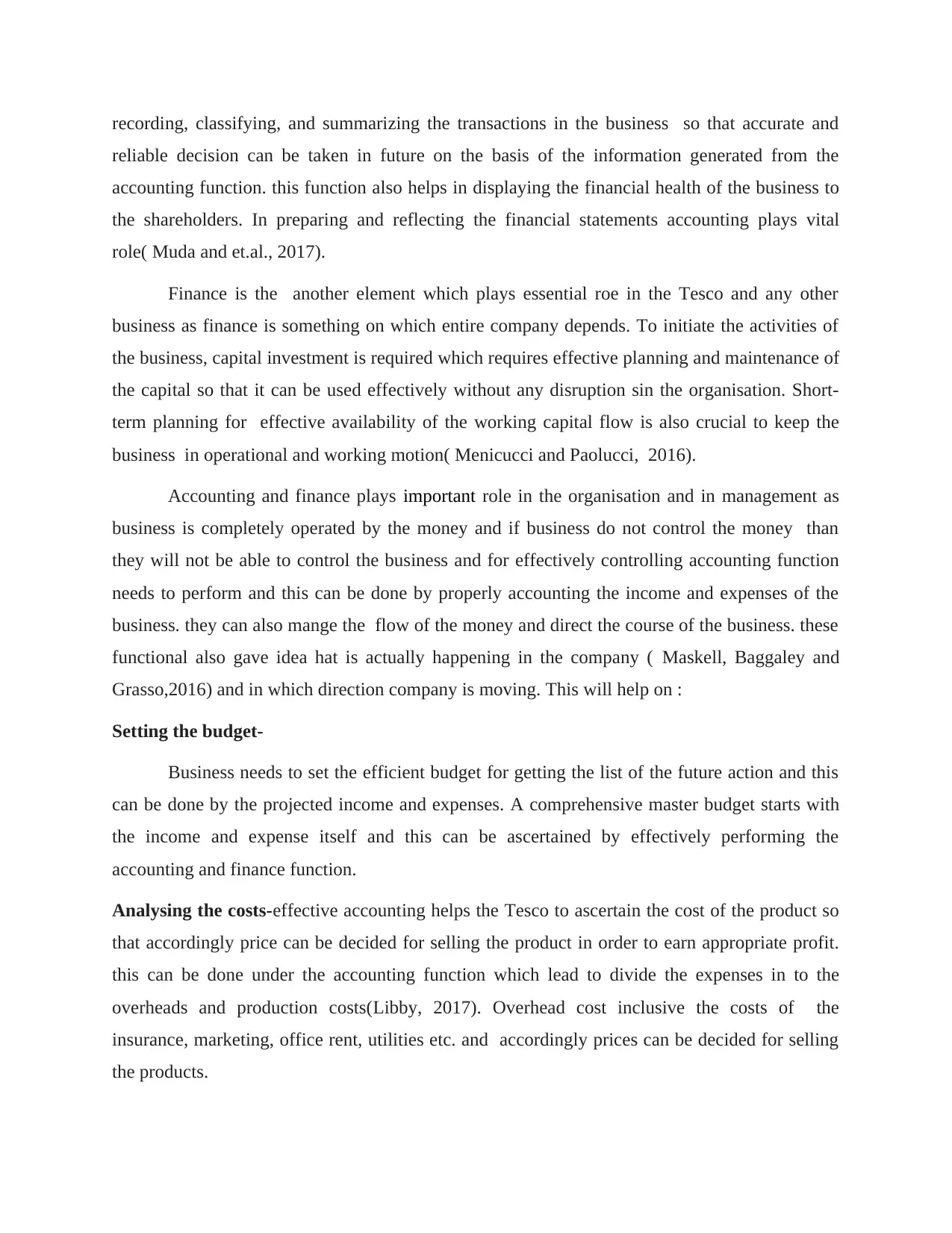
recording, classifying, and summarizing the transactions in the business so that accurate and
reliable decision can be taken in future on the basis of the information generated from the
accounting function. this function also helps in displaying the financial health of the business to
the shareholders. In preparing and reflecting the financial statements accounting plays vital
role( Muda and et.al., 2017).
Finance is the another element which plays essential roe in the Tesco and any other
business as finance is something on which entire company depends. To initiate the activities of
the business, capital investment is required which requires effective planning and maintenance of
the capital so that it can be used effectively without any disruption sin the organisation. Short-
term planning for effective availability of the working capital flow is also crucial to keep the
business in operational and working motion( Menicucci and Paolucci, 2016).
Accounting and finance plays important role in the organisation and in management as
business is completely operated by the money and if business do not control the money than
they will not be able to control the business and for effectively controlling accounting function
needs to perform and this can be done by properly accounting the income and expenses of the
business. they can also mange the flow of the money and direct the course of the business. these
functional also gave idea hat is actually happening in the company ( Maskell, Baggaley and
Grasso,2016) and in which direction company is moving. This will help on :
Setting the budget-
Business needs to set the efficient budget for getting the list of the future action and this
can be done by the projected income and expenses. A comprehensive master budget starts with
the income and expense itself and this can be ascertained by effectively performing the
accounting and finance function.
Analysing the costs-effective accounting helps the Tesco to ascertain the cost of the product so
that accordingly price can be decided for selling the product in order to earn appropriate profit.
this can be done under the accounting function which lead to divide the expenses in to the
overheads and production costs(Libby, 2017). Overhead cost inclusive the costs of the
insurance, marketing, office rent, utilities etc. and accordingly prices can be decided for selling
the products.
reliable decision can be taken in future on the basis of the information generated from the
accounting function. this function also helps in displaying the financial health of the business to
the shareholders. In preparing and reflecting the financial statements accounting plays vital
role( Muda and et.al., 2017).
Finance is the another element which plays essential roe in the Tesco and any other
business as finance is something on which entire company depends. To initiate the activities of
the business, capital investment is required which requires effective planning and maintenance of
the capital so that it can be used effectively without any disruption sin the organisation. Short-
term planning for effective availability of the working capital flow is also crucial to keep the
business in operational and working motion( Menicucci and Paolucci, 2016).
Accounting and finance plays important role in the organisation and in management as
business is completely operated by the money and if business do not control the money than
they will not be able to control the business and for effectively controlling accounting function
needs to perform and this can be done by properly accounting the income and expenses of the
business. they can also mange the flow of the money and direct the course of the business. these
functional also gave idea hat is actually happening in the company ( Maskell, Baggaley and
Grasso,2016) and in which direction company is moving. This will help on :
Setting the budget-
Business needs to set the efficient budget for getting the list of the future action and this
can be done by the projected income and expenses. A comprehensive master budget starts with
the income and expense itself and this can be ascertained by effectively performing the
accounting and finance function.
Analysing the costs-effective accounting helps the Tesco to ascertain the cost of the product so
that accordingly price can be decided for selling the product in order to earn appropriate profit.
this can be done under the accounting function which lead to divide the expenses in to the
overheads and production costs(Libby, 2017). Overhead cost inclusive the costs of the
insurance, marketing, office rent, utilities etc. and accordingly prices can be decided for selling
the products.
Paraphrase This Document
Need a fresh take? Get an instant paraphrase of this document with our AI Paraphraser

Hence, there are many more other elements like managing debt services, sets credit
terms, meeting compliance needs and finding trends etc(Henderson and et.al., 2015). which can
be generated by preforming the accounting and finance function effectively and efficiently which
ultimately helps Tesco in many ways.
There are many other accounting functions which are explained below as :
Management accounting function- it basically involves collecting, analysing and reporting
information about the operations and finance of the business. management accounting is the
process of preparing the management reports and accounts.
Advantages
It helps in providing accurate and timely financial and statistical information to the
manager to make further decisions(Gitman,Juchau and Flanagan, 2015). This accounting helps in presenting the clear picture to stakeholders of company so that
they can decide whether to invests in the company or not.
Disadvantages Management accounting is based on the financial and cost records-
It means both the financial and cost accounting information is used in the management
accounting system. The accuracy of the management account is completely based on the
accuracy of the financial and cost records , these records helps in determining the strength and
weakness of the management accounting. Management accounting is only tool-
Management accountant generally using the management accounting as a tool which
helps in giving the advice and facilitate the management in decision making(Gardoni, Guevara-
Lopez and Contento, 2016). the actual decisions and their implementation and follow up actions
are prerogative of the management.
Auditing function- it performs the necessary functions and provide independent opinion to
shareholders in truth and fairness of the financial statement prepare by them. It helps the auditor
to assess the risk in the company's' financial reports . Auditing helps in preparing and disclosing
the facts ion the basis of which transaction and reports are maintained
terms, meeting compliance needs and finding trends etc(Henderson and et.al., 2015). which can
be generated by preforming the accounting and finance function effectively and efficiently which
ultimately helps Tesco in many ways.
There are many other accounting functions which are explained below as :
Management accounting function- it basically involves collecting, analysing and reporting
information about the operations and finance of the business. management accounting is the
process of preparing the management reports and accounts.
Advantages
It helps in providing accurate and timely financial and statistical information to the
manager to make further decisions(Gitman,Juchau and Flanagan, 2015). This accounting helps in presenting the clear picture to stakeholders of company so that
they can decide whether to invests in the company or not.
Disadvantages Management accounting is based on the financial and cost records-
It means both the financial and cost accounting information is used in the management
accounting system. The accuracy of the management account is completely based on the
accuracy of the financial and cost records , these records helps in determining the strength and
weakness of the management accounting. Management accounting is only tool-
Management accountant generally using the management accounting as a tool which
helps in giving the advice and facilitate the management in decision making(Gardoni, Guevara-
Lopez and Contento, 2016). the actual decisions and their implementation and follow up actions
are prerogative of the management.
Auditing function- it performs the necessary functions and provide independent opinion to
shareholders in truth and fairness of the financial statement prepare by them. It helps the auditor
to assess the risk in the company's' financial reports . Auditing helps in preparing and disclosing
the facts ion the basis of which transaction and reports are maintained
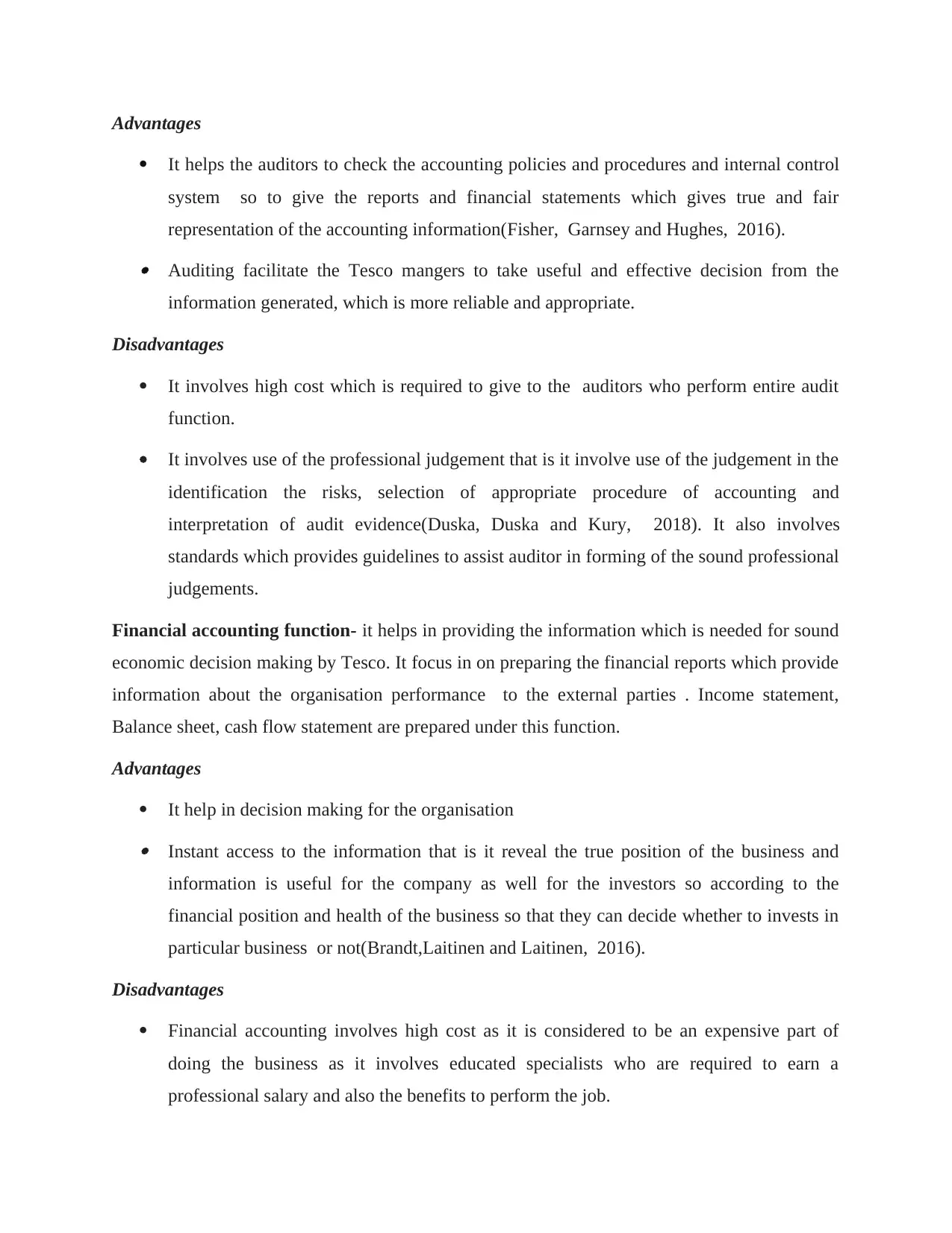
Advantages
It helps the auditors to check the accounting policies and procedures and internal control
system so to give the reports and financial statements which gives true and fair
representation of the accounting information(Fisher, Garnsey and Hughes, 2016). Auditing facilitate the Tesco mangers to take useful and effective decision from the
information generated, which is more reliable and appropriate.
Disadvantages
It involves high cost which is required to give to the auditors who perform entire audit
function.
It involves use of the professional judgement that is it involve use of the judgement in the
identification the risks, selection of appropriate procedure of accounting and
interpretation of audit evidence(Duska, Duska and Kury, 2018). It also involves
standards which provides guidelines to assist auditor in forming of the sound professional
judgements.
Financial accounting function- it helps in providing the information which is needed for sound
economic decision making by Tesco. It focus in on preparing the financial reports which provide
information about the organisation performance to the external parties . Income statement,
Balance sheet, cash flow statement are prepared under this function.
Advantages
It help in decision making for the organisation Instant access to the information that is it reveal the true position of the business and
information is useful for the company as well for the investors so according to the
financial position and health of the business so that they can decide whether to invests in
particular business or not(Brandt,Laitinen and Laitinen, 2016).
Disadvantages
Financial accounting involves high cost as it is considered to be an expensive part of
doing the business as it involves educated specialists who are required to earn a
professional salary and also the benefits to perform the job.
It helps the auditors to check the accounting policies and procedures and internal control
system so to give the reports and financial statements which gives true and fair
representation of the accounting information(Fisher, Garnsey and Hughes, 2016). Auditing facilitate the Tesco mangers to take useful and effective decision from the
information generated, which is more reliable and appropriate.
Disadvantages
It involves high cost which is required to give to the auditors who perform entire audit
function.
It involves use of the professional judgement that is it involve use of the judgement in the
identification the risks, selection of appropriate procedure of accounting and
interpretation of audit evidence(Duska, Duska and Kury, 2018). It also involves
standards which provides guidelines to assist auditor in forming of the sound professional
judgements.
Financial accounting function- it helps in providing the information which is needed for sound
economic decision making by Tesco. It focus in on preparing the financial reports which provide
information about the organisation performance to the external parties . Income statement,
Balance sheet, cash flow statement are prepared under this function.
Advantages
It help in decision making for the organisation Instant access to the information that is it reveal the true position of the business and
information is useful for the company as well for the investors so according to the
financial position and health of the business so that they can decide whether to invests in
particular business or not(Brandt,Laitinen and Laitinen, 2016).
Disadvantages
Financial accounting involves high cost as it is considered to be an expensive part of
doing the business as it involves educated specialists who are required to earn a
professional salary and also the benefits to perform the job.
⊘ This is a preview!⊘
Do you want full access?
Subscribe today to unlock all pages.

Trusted by 1+ million students worldwide
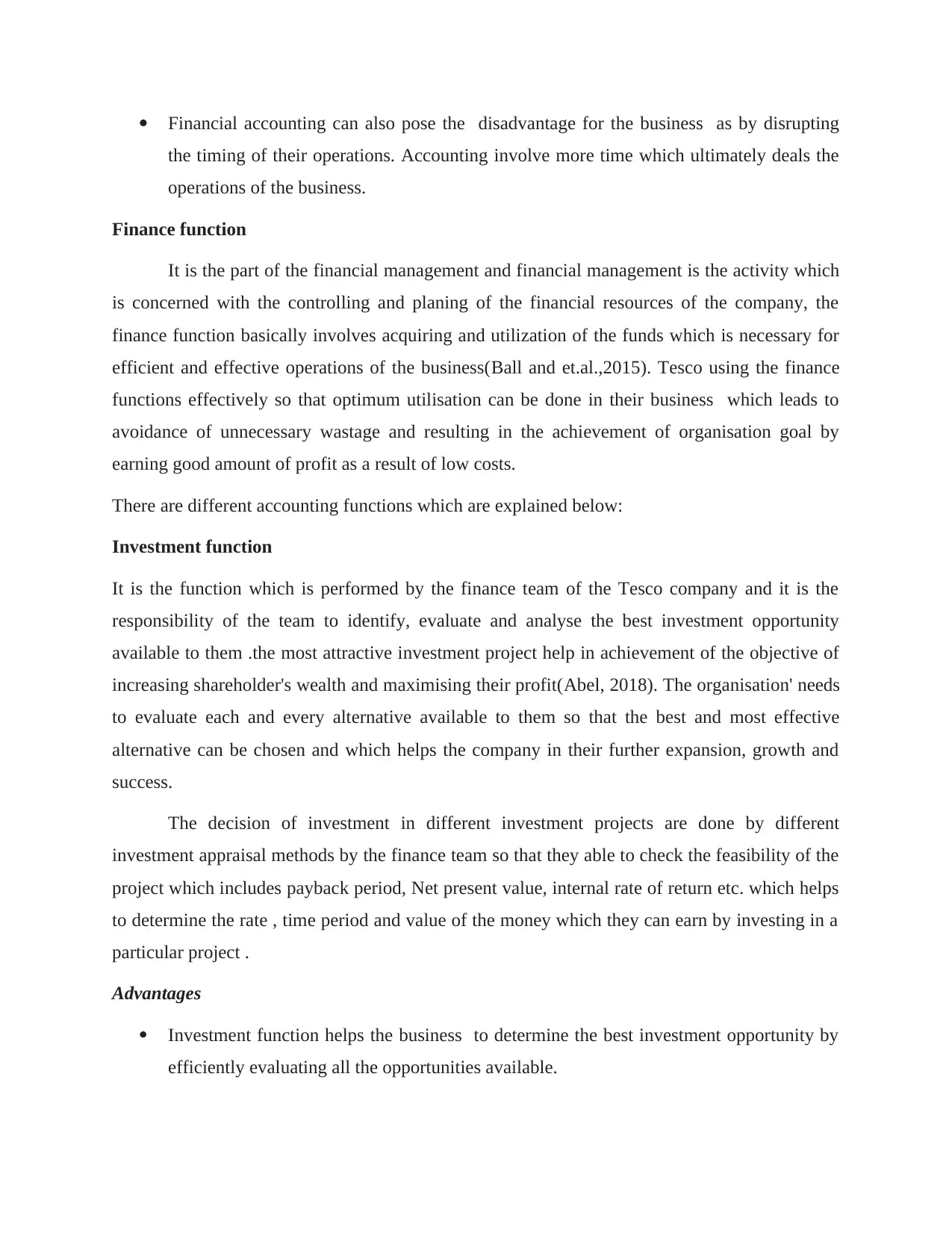
Financial accounting can also pose the disadvantage for the business as by disrupting
the timing of their operations. Accounting involve more time which ultimately deals the
operations of the business.
Finance function
It is the part of the financial management and financial management is the activity which
is concerned with the controlling and planing of the financial resources of the company, the
finance function basically involves acquiring and utilization of the funds which is necessary for
efficient and effective operations of the business(Ball and et.al.,2015). Tesco using the finance
functions effectively so that optimum utilisation can be done in their business which leads to
avoidance of unnecessary wastage and resulting in the achievement of organisation goal by
earning good amount of profit as a result of low costs.
There are different accounting functions which are explained below:
Investment function
It is the function which is performed by the finance team of the Tesco company and it is the
responsibility of the team to identify, evaluate and analyse the best investment opportunity
available to them .the most attractive investment project help in achievement of the objective of
increasing shareholder's wealth and maximising their profit(Abel, 2018). The organisation' needs
to evaluate each and every alternative available to them so that the best and most effective
alternative can be chosen and which helps the company in their further expansion, growth and
success.
The decision of investment in different investment projects are done by different
investment appraisal methods by the finance team so that they able to check the feasibility of the
project which includes payback period, Net present value, internal rate of return etc. which helps
to determine the rate , time period and value of the money which they can earn by investing in a
particular project .
Advantages
Investment function helps the business to determine the best investment opportunity by
efficiently evaluating all the opportunities available.
the timing of their operations. Accounting involve more time which ultimately deals the
operations of the business.
Finance function
It is the part of the financial management and financial management is the activity which
is concerned with the controlling and planing of the financial resources of the company, the
finance function basically involves acquiring and utilization of the funds which is necessary for
efficient and effective operations of the business(Ball and et.al.,2015). Tesco using the finance
functions effectively so that optimum utilisation can be done in their business which leads to
avoidance of unnecessary wastage and resulting in the achievement of organisation goal by
earning good amount of profit as a result of low costs.
There are different accounting functions which are explained below:
Investment function
It is the function which is performed by the finance team of the Tesco company and it is the
responsibility of the team to identify, evaluate and analyse the best investment opportunity
available to them .the most attractive investment project help in achievement of the objective of
increasing shareholder's wealth and maximising their profit(Abel, 2018). The organisation' needs
to evaluate each and every alternative available to them so that the best and most effective
alternative can be chosen and which helps the company in their further expansion, growth and
success.
The decision of investment in different investment projects are done by different
investment appraisal methods by the finance team so that they able to check the feasibility of the
project which includes payback period, Net present value, internal rate of return etc. which helps
to determine the rate , time period and value of the money which they can earn by investing in a
particular project .
Advantages
Investment function helps the business to determine the best investment opportunity by
efficiently evaluating all the opportunities available.
Paraphrase This Document
Need a fresh take? Get an instant paraphrase of this document with our AI Paraphraser
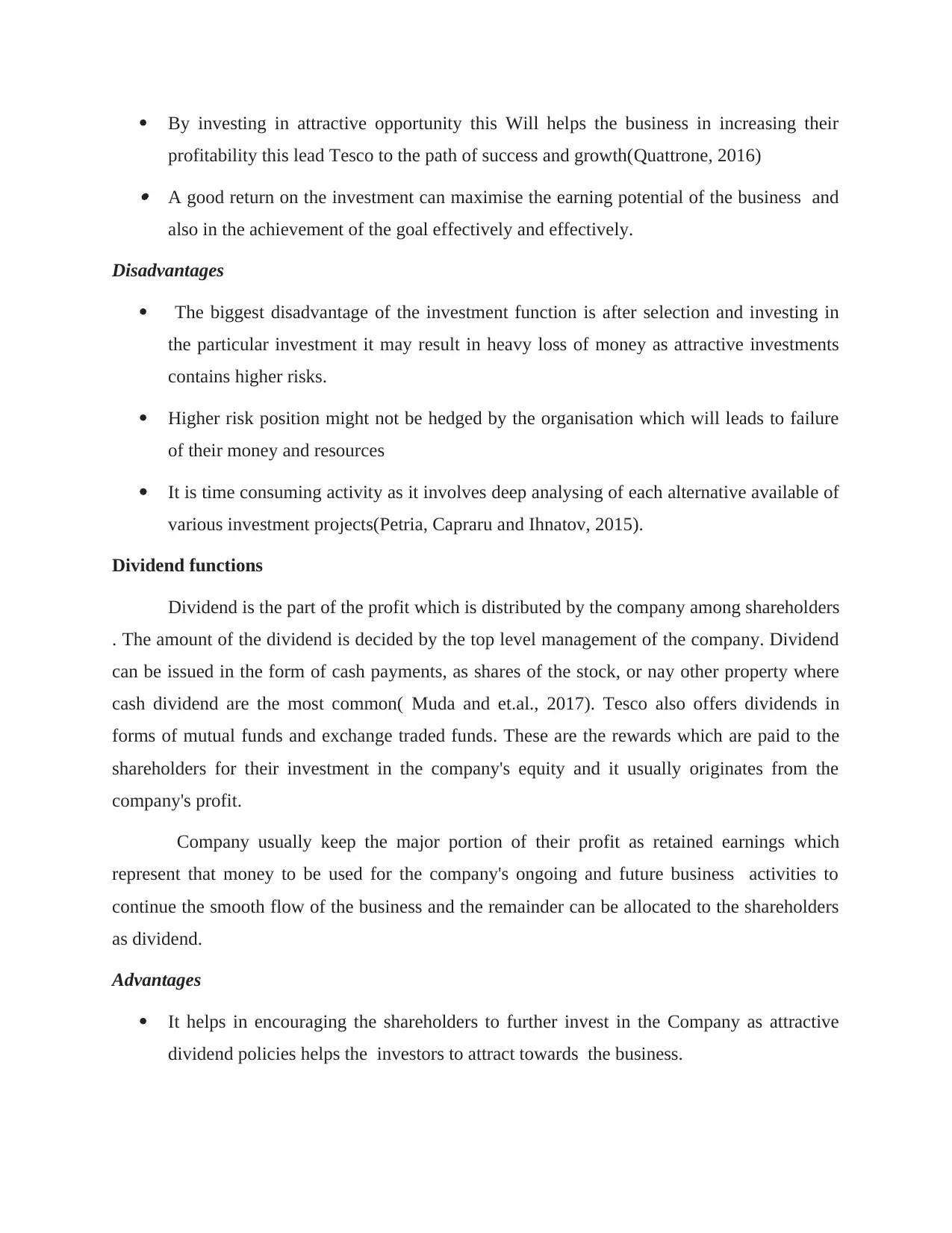
By investing in attractive opportunity this Will helps the business in increasing their
profitability this lead Tesco to the path of success and growth(Quattrone, 2016) A good return on the investment can maximise the earning potential of the business and
also in the achievement of the goal effectively and effectively.
Disadvantages
The biggest disadvantage of the investment function is after selection and investing in
the particular investment it may result in heavy loss of money as attractive investments
contains higher risks.
Higher risk position might not be hedged by the organisation which will leads to failure
of their money and resources
It is time consuming activity as it involves deep analysing of each alternative available of
various investment projects(Petria, Capraru and Ihnatov, 2015).
Dividend functions
Dividend is the part of the profit which is distributed by the company among shareholders
. The amount of the dividend is decided by the top level management of the company. Dividend
can be issued in the form of cash payments, as shares of the stock, or nay other property where
cash dividend are the most common( Muda and et.al., 2017). Tesco also offers dividends in
forms of mutual funds and exchange traded funds. These are the rewards which are paid to the
shareholders for their investment in the company's equity and it usually originates from the
company's profit.
Company usually keep the major portion of their profit as retained earnings which
represent that money to be used for the company's ongoing and future business activities to
continue the smooth flow of the business and the remainder can be allocated to the shareholders
as dividend.
Advantages
It helps in encouraging the shareholders to further invest in the Company as attractive
dividend policies helps the investors to attract towards the business.
profitability this lead Tesco to the path of success and growth(Quattrone, 2016) A good return on the investment can maximise the earning potential of the business and
also in the achievement of the goal effectively and effectively.
Disadvantages
The biggest disadvantage of the investment function is after selection and investing in
the particular investment it may result in heavy loss of money as attractive investments
contains higher risks.
Higher risk position might not be hedged by the organisation which will leads to failure
of their money and resources
It is time consuming activity as it involves deep analysing of each alternative available of
various investment projects(Petria, Capraru and Ihnatov, 2015).
Dividend functions
Dividend is the part of the profit which is distributed by the company among shareholders
. The amount of the dividend is decided by the top level management of the company. Dividend
can be issued in the form of cash payments, as shares of the stock, or nay other property where
cash dividend are the most common( Muda and et.al., 2017). Tesco also offers dividends in
forms of mutual funds and exchange traded funds. These are the rewards which are paid to the
shareholders for their investment in the company's equity and it usually originates from the
company's profit.
Company usually keep the major portion of their profit as retained earnings which
represent that money to be used for the company's ongoing and future business activities to
continue the smooth flow of the business and the remainder can be allocated to the shareholders
as dividend.
Advantages
It helps in encouraging the shareholders to further invest in the Company as attractive
dividend policies helps the investors to attract towards the business.
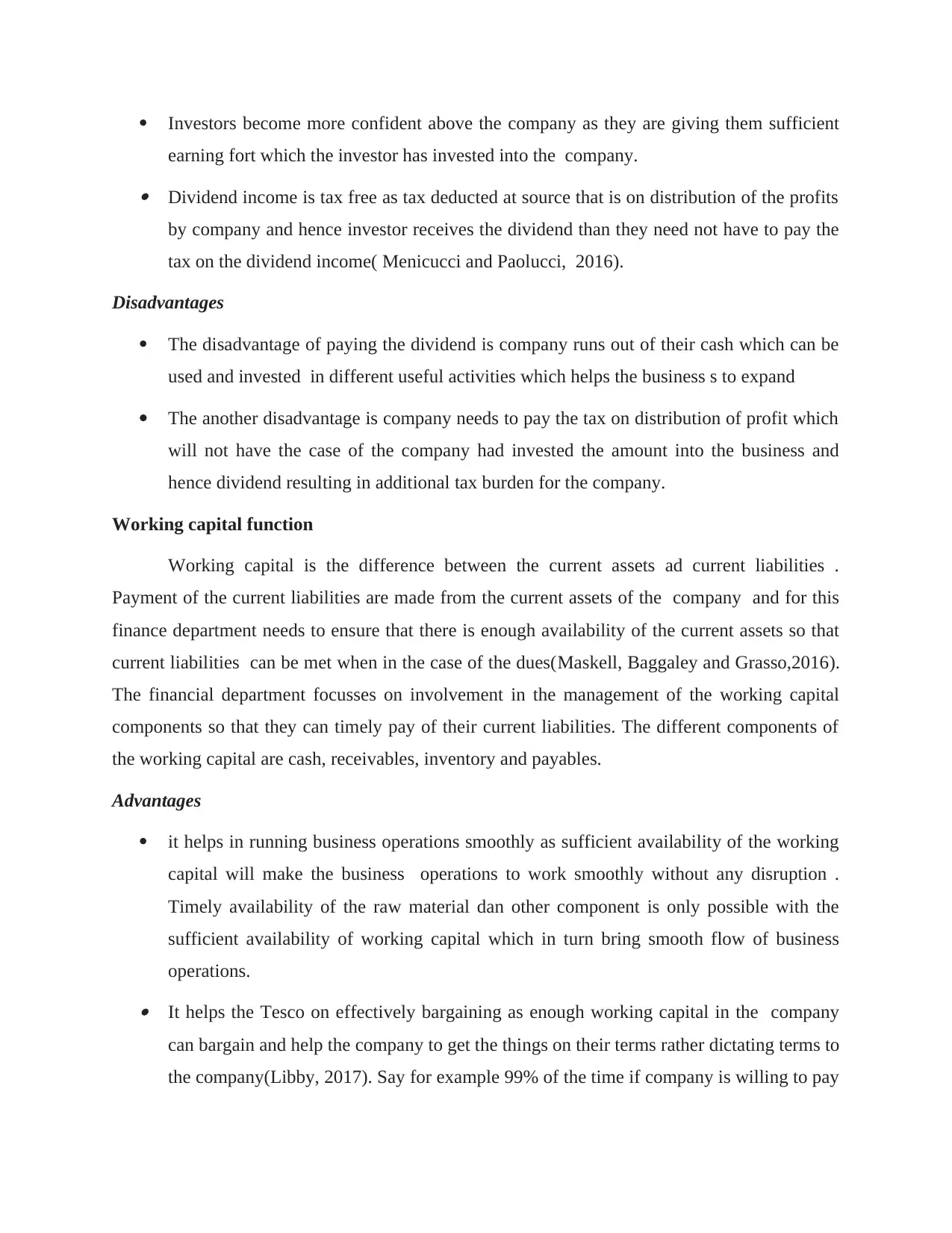
Investors become more confident above the company as they are giving them sufficient
earning fort which the investor has invested into the company. Dividend income is tax free as tax deducted at source that is on distribution of the profits
by company and hence investor receives the dividend than they need not have to pay the
tax on the dividend income( Menicucci and Paolucci, 2016).
Disadvantages
The disadvantage of paying the dividend is company runs out of their cash which can be
used and invested in different useful activities which helps the business s to expand
The another disadvantage is company needs to pay the tax on distribution of profit which
will not have the case of the company had invested the amount into the business and
hence dividend resulting in additional tax burden for the company.
Working capital function
Working capital is the difference between the current assets ad current liabilities .
Payment of the current liabilities are made from the current assets of the company and for this
finance department needs to ensure that there is enough availability of the current assets so that
current liabilities can be met when in the case of the dues(Maskell, Baggaley and Grasso,2016).
The financial department focusses on involvement in the management of the working capital
components so that they can timely pay of their current liabilities. The different components of
the working capital are cash, receivables, inventory and payables.
Advantages
it helps in running business operations smoothly as sufficient availability of the working
capital will make the business operations to work smoothly without any disruption .
Timely availability of the raw material dan other component is only possible with the
sufficient availability of working capital which in turn bring smooth flow of business
operations. It helps the Tesco on effectively bargaining as enough working capital in the company
can bargain and help the company to get the things on their terms rather dictating terms to
the company(Libby, 2017). Say for example 99% of the time if company is willing to pay
earning fort which the investor has invested into the company. Dividend income is tax free as tax deducted at source that is on distribution of the profits
by company and hence investor receives the dividend than they need not have to pay the
tax on the dividend income( Menicucci and Paolucci, 2016).
Disadvantages
The disadvantage of paying the dividend is company runs out of their cash which can be
used and invested in different useful activities which helps the business s to expand
The another disadvantage is company needs to pay the tax on distribution of profit which
will not have the case of the company had invested the amount into the business and
hence dividend resulting in additional tax burden for the company.
Working capital function
Working capital is the difference between the current assets ad current liabilities .
Payment of the current liabilities are made from the current assets of the company and for this
finance department needs to ensure that there is enough availability of the current assets so that
current liabilities can be met when in the case of the dues(Maskell, Baggaley and Grasso,2016).
The financial department focusses on involvement in the management of the working capital
components so that they can timely pay of their current liabilities. The different components of
the working capital are cash, receivables, inventory and payables.
Advantages
it helps in running business operations smoothly as sufficient availability of the working
capital will make the business operations to work smoothly without any disruption .
Timely availability of the raw material dan other component is only possible with the
sufficient availability of working capital which in turn bring smooth flow of business
operations. It helps the Tesco on effectively bargaining as enough working capital in the company
can bargain and help the company to get the things on their terms rather dictating terms to
the company(Libby, 2017). Say for example 99% of the time if company is willing to pay
⊘ This is a preview!⊘
Do you want full access?
Subscribe today to unlock all pages.

Trusted by 1+ million students worldwide
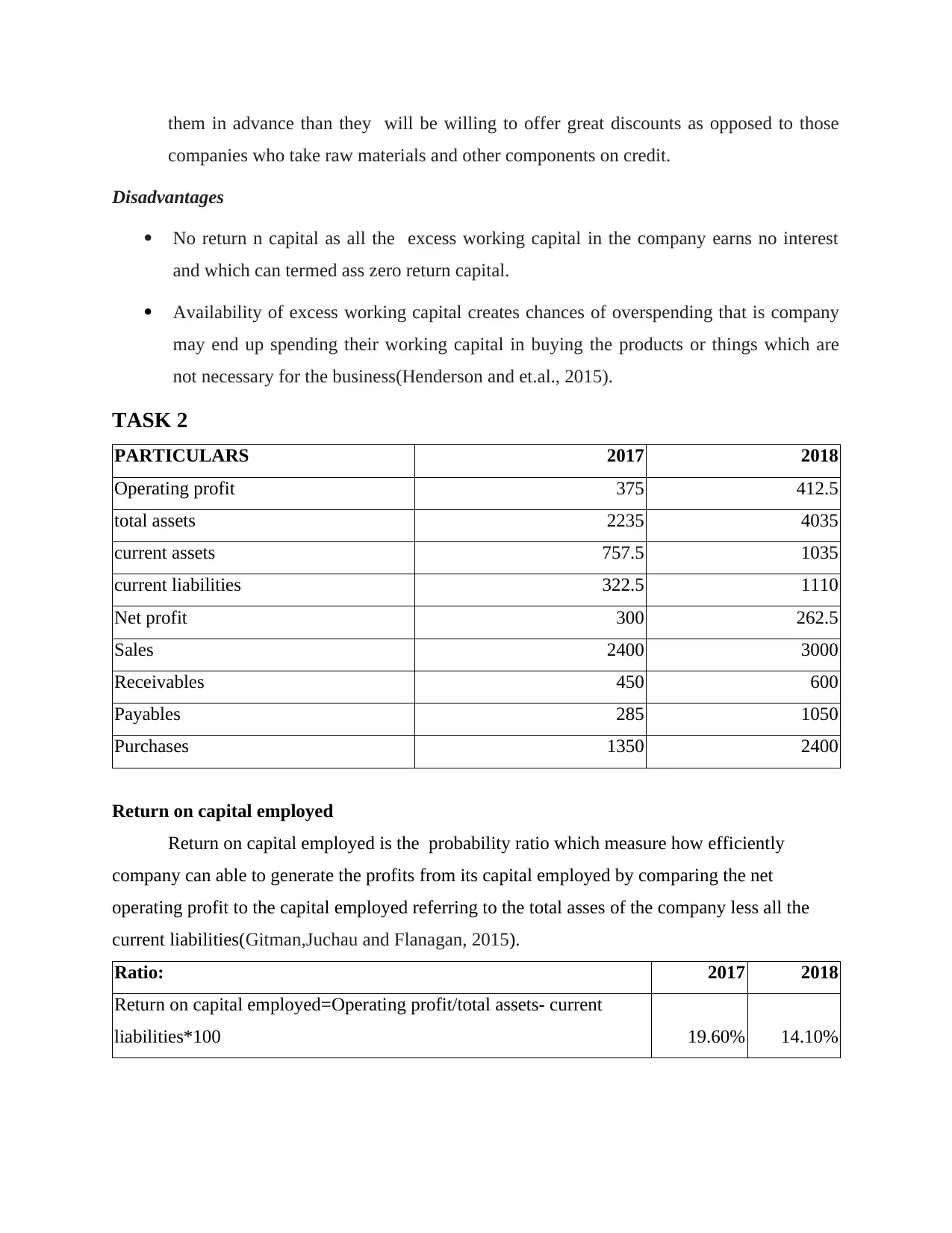
them in advance than they will be willing to offer great discounts as opposed to those
companies who take raw materials and other components on credit.
Disadvantages
No return n capital as all the excess working capital in the company earns no interest
and which can termed ass zero return capital.
Availability of excess working capital creates chances of overspending that is company
may end up spending their working capital in buying the products or things which are
not necessary for the business(Henderson and et.al., 2015).
TASK 2
PARTICULARS 2017 2018
Operating profit 375 412.5
total assets 2235 4035
current assets 757.5 1035
current liabilities 322.5 1110
Net profit 300 262.5
Sales 2400 3000
Receivables 450 600
Payables 285 1050
Purchases 1350 2400
Return on capital employed
Return on capital employed is the probability ratio which measure how efficiently
company can able to generate the profits from its capital employed by comparing the net
operating profit to the capital employed referring to the total asses of the company less all the
current liabilities(Gitman,Juchau and Flanagan, 2015).
Ratio: 2017 2018
Return on capital employed=Operating profit/total assets- current
liabilities*100 19.60% 14.10%
companies who take raw materials and other components on credit.
Disadvantages
No return n capital as all the excess working capital in the company earns no interest
and which can termed ass zero return capital.
Availability of excess working capital creates chances of overspending that is company
may end up spending their working capital in buying the products or things which are
not necessary for the business(Henderson and et.al., 2015).
TASK 2
PARTICULARS 2017 2018
Operating profit 375 412.5
total assets 2235 4035
current assets 757.5 1035
current liabilities 322.5 1110
Net profit 300 262.5
Sales 2400 3000
Receivables 450 600
Payables 285 1050
Purchases 1350 2400
Return on capital employed
Return on capital employed is the probability ratio which measure how efficiently
company can able to generate the profits from its capital employed by comparing the net
operating profit to the capital employed referring to the total asses of the company less all the
current liabilities(Gitman,Juchau and Flanagan, 2015).
Ratio: 2017 2018
Return on capital employed=Operating profit/total assets- current
liabilities*100 19.60% 14.10%
Paraphrase This Document
Need a fresh take? Get an instant paraphrase of this document with our AI Paraphraser
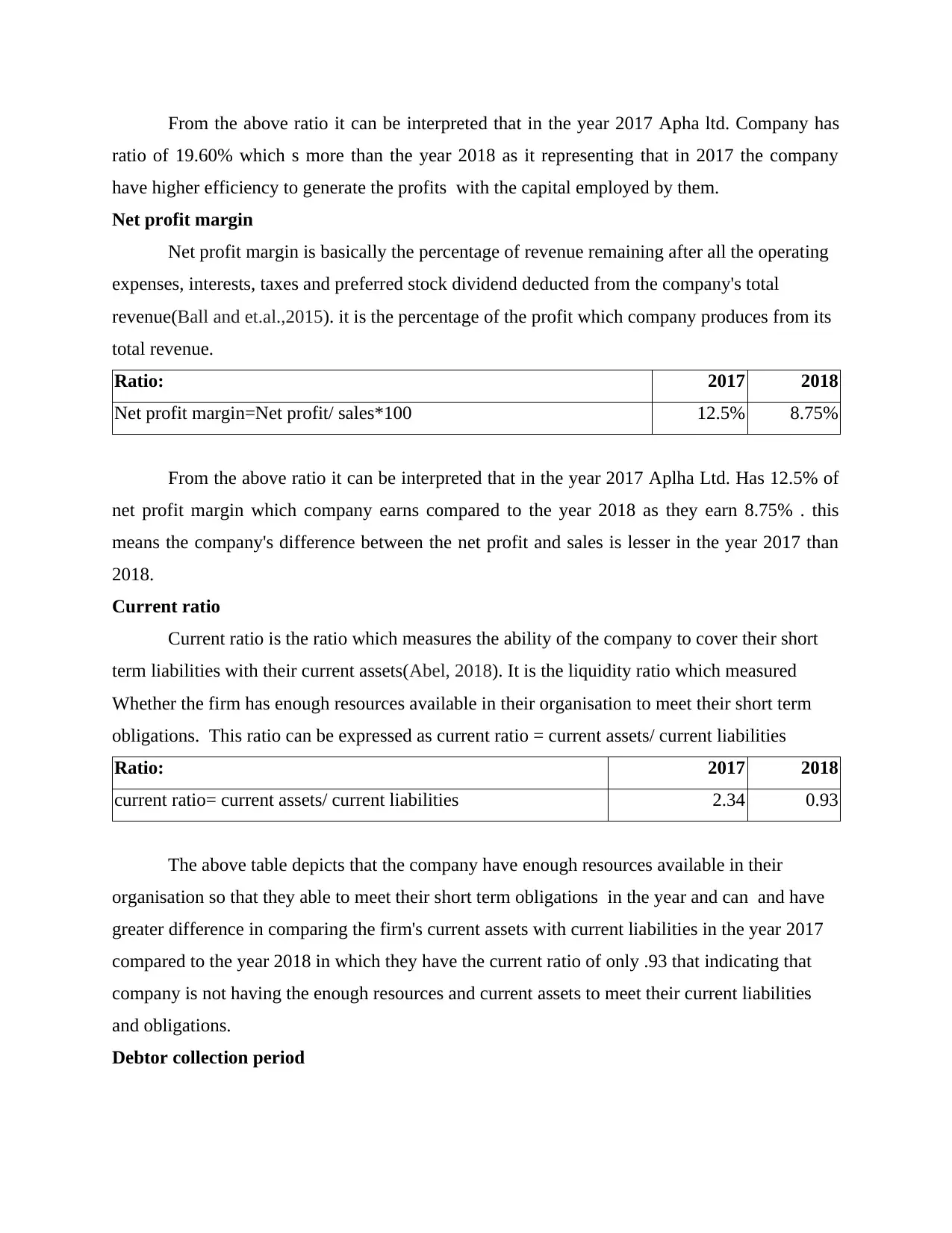
From the above ratio it can be interpreted that in the year 2017 Apha ltd. Company has
ratio of 19.60% which s more than the year 2018 as it representing that in 2017 the company
have higher efficiency to generate the profits with the capital employed by them.
Net profit margin
Net profit margin is basically the percentage of revenue remaining after all the operating
expenses, interests, taxes and preferred stock dividend deducted from the company's total
revenue(Ball and et.al.,2015). it is the percentage of the profit which company produces from its
total revenue.
Ratio: 2017 2018
Net profit margin=Net profit/ sales*100 12.5% 8.75%
From the above ratio it can be interpreted that in the year 2017 Aplha Ltd. Has 12.5% of
net profit margin which company earns compared to the year 2018 as they earn 8.75% . this
means the company's difference between the net profit and sales is lesser in the year 2017 than
2018.
Current ratio
Current ratio is the ratio which measures the ability of the company to cover their short
term liabilities with their current assets(Abel, 2018). It is the liquidity ratio which measured
Whether the firm has enough resources available in their organisation to meet their short term
obligations. This ratio can be expressed as current ratio = current assets/ current liabilities
Ratio: 2017 2018
current ratio= current assets/ current liabilities 2.34 0.93
The above table depicts that the company have enough resources available in their
organisation so that they able to meet their short term obligations in the year and can and have
greater difference in comparing the firm's current assets with current liabilities in the year 2017
compared to the year 2018 in which they have the current ratio of only .93 that indicating that
company is not having the enough resources and current assets to meet their current liabilities
and obligations.
Debtor collection period
ratio of 19.60% which s more than the year 2018 as it representing that in 2017 the company
have higher efficiency to generate the profits with the capital employed by them.
Net profit margin
Net profit margin is basically the percentage of revenue remaining after all the operating
expenses, interests, taxes and preferred stock dividend deducted from the company's total
revenue(Ball and et.al.,2015). it is the percentage of the profit which company produces from its
total revenue.
Ratio: 2017 2018
Net profit margin=Net profit/ sales*100 12.5% 8.75%
From the above ratio it can be interpreted that in the year 2017 Aplha Ltd. Has 12.5% of
net profit margin which company earns compared to the year 2018 as they earn 8.75% . this
means the company's difference between the net profit and sales is lesser in the year 2017 than
2018.
Current ratio
Current ratio is the ratio which measures the ability of the company to cover their short
term liabilities with their current assets(Abel, 2018). It is the liquidity ratio which measured
Whether the firm has enough resources available in their organisation to meet their short term
obligations. This ratio can be expressed as current ratio = current assets/ current liabilities
Ratio: 2017 2018
current ratio= current assets/ current liabilities 2.34 0.93
The above table depicts that the company have enough resources available in their
organisation so that they able to meet their short term obligations in the year and can and have
greater difference in comparing the firm's current assets with current liabilities in the year 2017
compared to the year 2018 in which they have the current ratio of only .93 that indicating that
company is not having the enough resources and current assets to meet their current liabilities
and obligations.
Debtor collection period
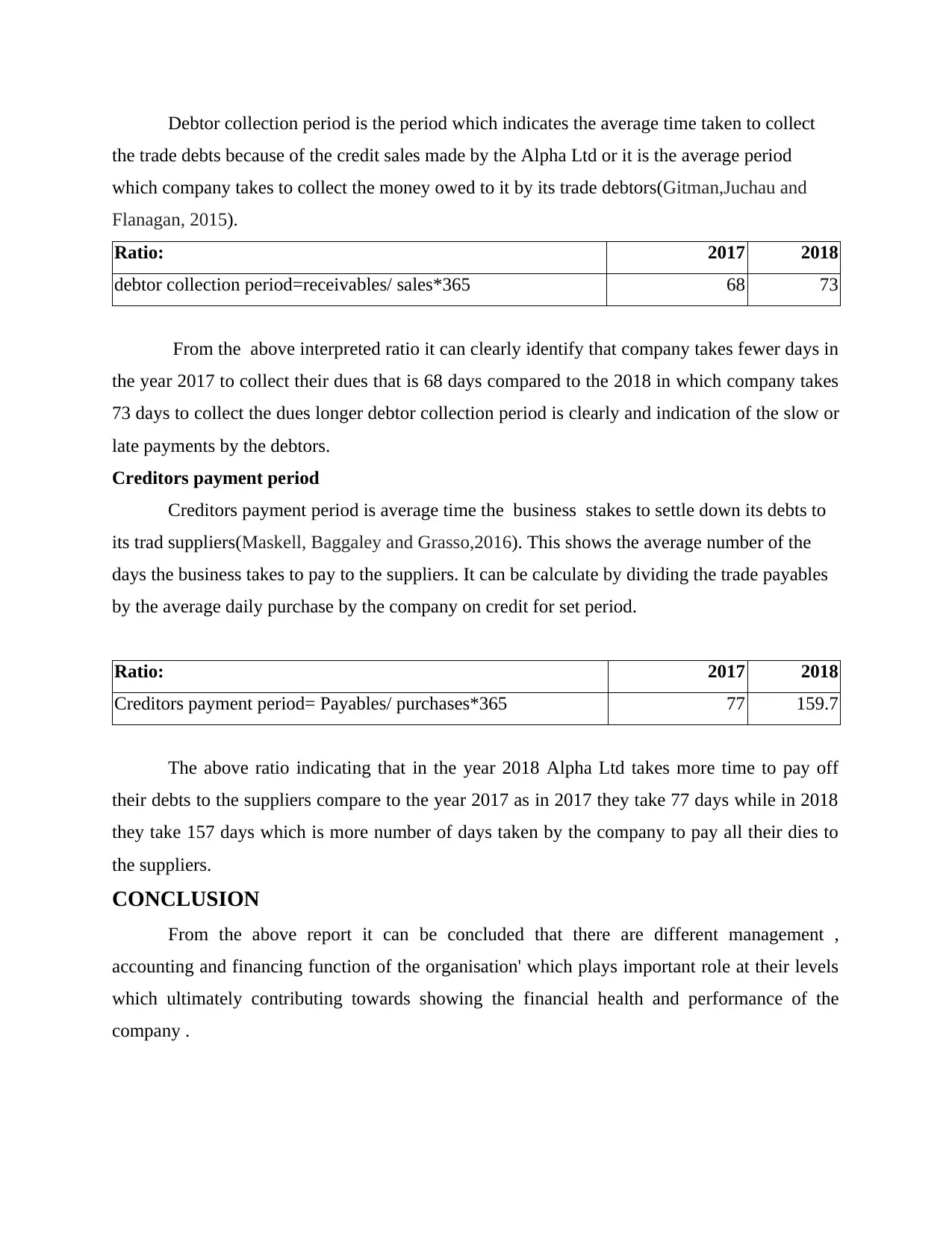
Debtor collection period is the period which indicates the average time taken to collect
the trade debts because of the credit sales made by the Alpha Ltd or it is the average period
which company takes to collect the money owed to it by its trade debtors(Gitman,Juchau and
Flanagan, 2015).
Ratio: 2017 2018
debtor collection period=receivables/ sales*365 68 73
From the above interpreted ratio it can clearly identify that company takes fewer days in
the year 2017 to collect their dues that is 68 days compared to the 2018 in which company takes
73 days to collect the dues longer debtor collection period is clearly and indication of the slow or
late payments by the debtors.
Creditors payment period
Creditors payment period is average time the business stakes to settle down its debts to
its trad suppliers(Maskell, Baggaley and Grasso,2016). This shows the average number of the
days the business takes to pay to the suppliers. It can be calculate by dividing the trade payables
by the average daily purchase by the company on credit for set period.
Ratio: 2017 2018
Creditors payment period= Payables/ purchases*365 77 159.7
The above ratio indicating that in the year 2018 Alpha Ltd takes more time to pay off
their debts to the suppliers compare to the year 2017 as in 2017 they take 77 days while in 2018
they take 157 days which is more number of days taken by the company to pay all their dies to
the suppliers.
CONCLUSION
From the above report it can be concluded that there are different management ,
accounting and financing function of the organisation' which plays important role at their levels
which ultimately contributing towards showing the financial health and performance of the
company .
the trade debts because of the credit sales made by the Alpha Ltd or it is the average period
which company takes to collect the money owed to it by its trade debtors(Gitman,Juchau and
Flanagan, 2015).
Ratio: 2017 2018
debtor collection period=receivables/ sales*365 68 73
From the above interpreted ratio it can clearly identify that company takes fewer days in
the year 2017 to collect their dues that is 68 days compared to the 2018 in which company takes
73 days to collect the dues longer debtor collection period is clearly and indication of the slow or
late payments by the debtors.
Creditors payment period
Creditors payment period is average time the business stakes to settle down its debts to
its trad suppliers(Maskell, Baggaley and Grasso,2016). This shows the average number of the
days the business takes to pay to the suppliers. It can be calculate by dividing the trade payables
by the average daily purchase by the company on credit for set period.
Ratio: 2017 2018
Creditors payment period= Payables/ purchases*365 77 159.7
The above ratio indicating that in the year 2018 Alpha Ltd takes more time to pay off
their debts to the suppliers compare to the year 2017 as in 2017 they take 77 days while in 2018
they take 157 days which is more number of days taken by the company to pay all their dies to
the suppliers.
CONCLUSION
From the above report it can be concluded that there are different management ,
accounting and financing function of the organisation' which plays important role at their levels
which ultimately contributing towards showing the financial health and performance of the
company .
⊘ This is a preview!⊘
Do you want full access?
Subscribe today to unlock all pages.

Trusted by 1+ million students worldwide
1 out of 14
Related Documents
Your All-in-One AI-Powered Toolkit for Academic Success.
+13062052269
info@desklib.com
Available 24*7 on WhatsApp / Email
![[object Object]](/_next/static/media/star-bottom.7253800d.svg)
Unlock your academic potential
Copyright © 2020–2025 A2Z Services. All Rights Reserved. Developed and managed by ZUCOL.




